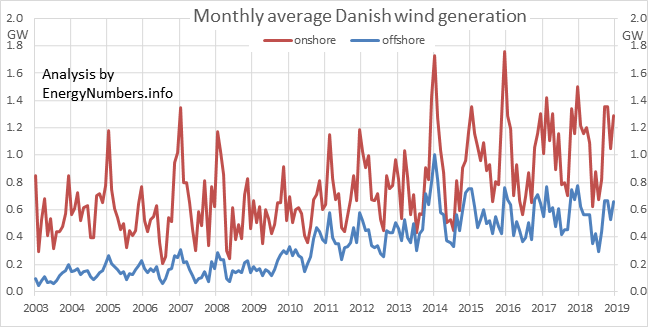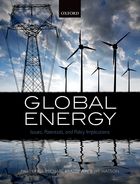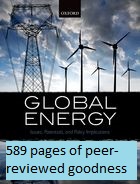 Here are the average capacity factors of every Danish offshore wind farm, newly updated to include data to the end of 2018. Compare these with the capacity factors for German, and UK, and Belgian offshore wind farms.
Here are the average capacity factors of every Danish offshore wind farm, newly updated to include data to the end of 2018. Compare these with the capacity factors for German, and UK, and Belgian offshore wind farms.
Category: public
Capacity factors at Danish offshore wind farms
2050 Calculator
Introducing the EnergyNumbers 2050 Pathways calculator
The DECC 2050 calculator is a good start at producing a toy model to give some ideas of the trade-offs, and approximate orders of magnitude of costs involved in converting Britain’s energy systems into a low-carbon system.
But it has its flaws.
So I’ve revised some of the model’s weakest parts, and re-released it. Here’s the EnergyNumbers 2050 Pathways calculator
A summary of the changes (most recent, first)
- Added a new option to change the amount of fossil-fuels (coal, gas, oil) extracted in the UK. This option exists in the DECC spreadsheet, but wasn’t previously available in the web interface.
- Added a whole new section with performance against national and international targets. In the top-left corner of every page, you’ll find indicators showing progress against targets. Click on them to read an explanation of each target, and how well the selected pathway performs against each.
- Change nuclear level 1 to phaseout by 2020; bumped all the other levels up by one (so old level 1 is new level 2; old level 3 is new level 4), and updated all the “expert” pathways accordingly. Old level 4 wasn’t plausible, wasn’t used in any of the “expert” pathways, and so has been removed
- Added estimated damage costs for greeenhouse gases: low £70/tCO2e; medium £100/tCO2e; high £200/tCO2e
- Added estimates of nuclear liability costs: low 0p/kWh; medium 11p/kWh; high 100p/kWh
- The choice of car and van techology, between fuel cells and electric batteries, is a category scale (A,B,C,D), not ascending order of difficulty (1-4)
- Ensure coal capacity has a floor of zero
- Selecting biomass plant will not drive up coal use
- Updated nuclear build costs: high £4.548/Wp rising to £5.072/Wp; medium £3.50/Wp; low £2.478/Wp
- Onshore wind, level 4 upgraded to hit 50GWp by 2020 and stay steady
- Offshore wind fixed-foundation, level 4, from 2020 onwards, upgraded to 10GWp annual installation rate
Why the Green Economy?
A while ago, the French Chamber of Commerce in Great Britain invited me to write an article for their magazine’s (INFO) special edition on the Green Economy. Here’s the article, updated (Feb 2013) and with links added to further information
Why the Green Economy? Summary
Markets that exclude the impact on natural capital are distorted. Markets that exclude the costs of pollution are distorted. Markets that allow the Tragedy of the Commons are distorted. These distorted markets represent economic efficiency, and leave us all worse off.
The polluter-pays principle corrects the market distortion caused by unpriced pollution. Joint-stewardship agreements allow us to sustainably manage common resources, preventing the Tragedy of the Commons. Tracking changes to the value of our natural capital base is just as important as tracking transaction values: both represent changes to our wealth.
The Green Economy, in all those forms, is here because it fixes problems that have been accumulating for decades. Why the Green Economy? Because in the long run, the Green Economy leaves us better off, environmentally and economically.
Background to the Green Economy
The Green Economy is worth hundreds of billions of pounds (euro / dollars) each year; it spans many sectors including the most fundamental ones of energy, food and water supplies; and in the last fifty years, it’s gone from fringe to mainstream, growing in value and coverage each year. For example, in 2011, global investment in renewable energy was US$257bn; and there are electric cars on the market that can out-run a Porsche.
But the Green Economy has been around for quite some time, and its academic foundations, in the “polluter-pays principle” dates back to the early decades of the twentieth century. However, more recently, the problems have become global in scale, and the solutions have required international co-operation, for example in banning the industrial production of some of the worst ozone-depleting chemicals. The next wave of problems and solutions dwarfs what has gone before, requiring revolutionary changes to how we generate electricity, how we heat our homes and offices, how we power our transport systems, how we manage our livestock and fertilise our crops. The economic risks (and opportunities) are orders of magnitude greater than what has gone before.
Read more…
Live mapping of ships building Walney offshore windfarm
The map below shows the live positions of ships working on the Walney offshore wind farm, off the coast of Blackpool and Barrow-in-Furness. It’s not as good as sitting on the dock of the bay, watching the ships roll in and roll out again, but it’s better than a slap in the face with a wet cod.Read more…
Units of power: why I heart the gigawatt
“Why are you using those units for power? Why don’t you use something else?”
Is that what you’re asking? Is it?
So how about a detailed explanation of why gigawatts just rock, and all the others just get on my tit? And if that is what you are thinking, then (1) you might be a bit odd, but (2) you’re in luck:
Why gigawatts rock
It’s part of the standardised SI system of units understood around the world, and it enables numbers from different countries and different times to be compared.
Standardising on one unit of power makes a lot of sense. That is what the SI system does. Switching between mtoe/y, mboe/d, TWh/y, EJ/y, quads/y, kWh/person/d is a pain – I guess we all agree on that.
Read more…
Photovoltaics in Germany: has solar power been worth it?
Recently, commentators have suggested that the German experience of providing feed-in tariffs to subsidise photovoltaics [PV] has been a Bad Thing, but much of it is based on a flawed study from the RWI think-tank ![]() .
.
Chris Goodall, George Monbiot (twice), and the Low Carbon Kid have all joined in. Jeremy Leggett has picked up the defence several times now. Let’s look at the RWI claims. But first, a trip to the shop …
Read more…
Decarbonising Nitrogen fertiliser production
Before we had lots of natural gas, nitrogen fertiliser was produced using the Haber-Bosch process. In our low-carbon future, we’ll be making use of it, or something like it, once more. It uses Hydrogen and Nitrogen with energy and an iron catalyst to produce ammonia, which can then form the basis of nitrogen fertilisers. And this process will be of assistance in the move to decarbonise. We can build coastal energy-intensive plants, right on the transmission network, for example at the points where offshore wind farms come ashore, and just operate them when energy is the cheapest. This would help balance demand and supply, at those times when electricity production from wind, wave, tidal and solar energy is highest, and at the same time it helps decarbonise the agriculture sector.
Read more…

